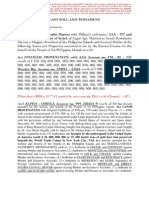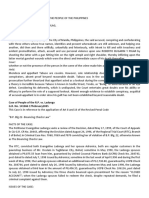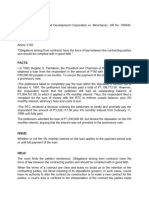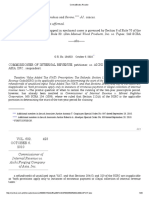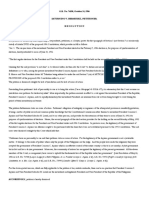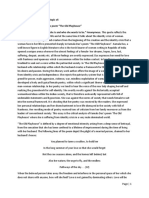DAR v. Sutton Case Digest
DAR v. Sutton Case Digest
Uploaded by
pa0l0sCopyright:
Available Formats
DAR v. Sutton Case Digest
DAR v. Sutton Case Digest
Uploaded by
pa0l0sOriginal Title
Copyright
Available Formats
Share this document
Did you find this document useful?
Is this content inappropriate?
Copyright:
Available Formats
DAR v. Sutton Case Digest
DAR v. Sutton Case Digest
Uploaded by
pa0l0sCopyright:
Available Formats
DAR vs. Delia T.
Sutton
Issue: Whether or not DAR Administrative Order (A.O.) No. 9, series of 1993
unconstitutional and violative of the Constitution.
Facts:
The case at bar involves a land in Aroroy, Masbate, inherited by
respondents which has been devoted exclusively to cow and calf breeding.
On October 26, 1987, pursuant to the then existing agrarian reform program
of the government, respondents made a voluntary offer to sell (VOS) their
landholdings to petitioner DAR to avail of certain incentives under the law.
On June 10, 1988, a new agrarian law, Republic Act (R.A.) No. 6657, also
known as the Comprehensive Agrarian Reform Law (CARL) of 1988, took
effect. It included in its coverage farms used for raising livestock, poultry and
swine.
On December 4, 1990, in an en banc decision in the case of Luz
Farms v. Secretary of DAR, this Court ruled that lands devoted to livestock
and poultry-raising are not included in the definition of agricultural land.
Hence, we declared as unconstitutional certain provisions of the CARL
insofar as they included livestock farms in the coverage of agrarian reform.
Thus the owner withdraw their offer to sell the property as their landholding
was devoted exclusively to cattle-raising and thus exempted from the
coverage of the CARL
On December 27, 1993, DAR issued A.O. No. 9, series of 1993,
which provided that only portions of private agricultural lands used for the
raising of livestock, poultry and swine as of June 15, 1988 shall be excluded
from the coverage of the CARL. In determining the area of land to be
excluded, the A.O. fixed the following retention limits, viz: 1:1 animal-land
ratio (i.e., 1 hectare of land per 1 head of animal shall be retained by the
landowner), and a ratio of 1.7815 hectares for livestock infrastructure for
every 21 heads of cattle shall likewise be excluded from the operations of the
CARL. This AO prescribes a maximum retention limit for owners of lands
devoted to livestock raising.
On September 14, 1995, then DAR Secretary Ernesto D. Garilao
issued an Order partially granting the application of respondents for
exemption from the coverage of CARL. Applying the retention limits outlined
in the DAR A.O. No. 9, petitioner exempted 1,209 hectares of respondents'
land for grazing purposes, and a maximum of 102.5635 hectares for
infrastructure. Petitioner ordered the rest of respondents' landholding to be
segregated and placed under Compulsory Acquisition. D
Held:
WHEREFORE, premises considered, DAR Administrative
Order No. 09, Series of 1993 is hereby DECLARED null
and void. The assailed order of the Office of the President
dated 09 October 2001 in so far as it affirmed the
Department of Agrarian Reform's ruling that petitioners'
landholding is covered by the agrarian reform program of
the government is REVERSED and SET ASIDE.
Administrative agencies are endowed with powers legislative in
nature, i.e., the power to make rules and regulations. However, while
administrative rules and regulations have the force and effect of law, they are
not immune from judicial review. They may be properly challenged before the
courts to ensure that they do not violate the Constitution and no grave abuse
of administrative discretion is committed by the administrative body
concerned.
The fundamental rule in administrative law is that, to be valid,
administrative rules and regulations must be issued by authority of a law
and must not contravene the provisions of the Constitution.
In the case at bar, we find that the impugned A.O. is invalid as it contravenes
the Constitution. The A.O. sought to regulate livestock farms by including
them in the coverage of agrarian reform and prescribing a maximum
retention limit for their ownership. However, the deliberations of the 1987
Constitutional Commission show a clear intent to exclude, inter alia, all
lands exclusively devoted to livestock, swine and poultry-raising. The
Court clarified in the Luz Farms case that livestock, swine and poultryraising are industrial activities and do not fall within the definition of
"agriculture" or "agricultural activity." The raising of livestock, swine and
poultry is different from crop or tree farming. It is an industrial, not an
agricultural, activity. A great portion of the investment in this enterprise is in
the form of industrial fixed assets, such as: animal housing structures and
facilities, drainage, waterers and blowers, feedmill with grinders, mixers,
conveyors, exhausts and generators, extensive warehousing facilities for
feeds and other supplies, anti-pollution equipment like bio-gas and digester
plants augmented by lagoons and concrete ponds, deepwells, elevated water
tanks, pumphouses, sprayers, and other technological appurtenances.
Clearly, petitioner DAR has no power to regulate livestock farms
which have been exempted by the Constitution from the coverage of
agrarian reform. It has exceeded its power in issuing the assailed A.O.
The subsequent case of Natalia Realty, Inc. v. DAR reiterated our ruling in
the Luz Farms case. In Natalia Realty, the Court held that industrial,
commercial and residential lands are not covered by the CARL. We stressed
anew that while Section 4 of R.A. No. 6657 provides that the CARL shall
cover all public and private agricultural lands, the term "agricultural
land" does not include lands classified as mineral, forest, residential,
commercial or industrial. Thus, in Natalia Realty, even portions of the
Antipolo Hills Subdivision, which are arable yet still undeveloped, could not
be considered as agricultural lands subject to agrarian reform as these lots
were already classified as residential lands.
You might also like
- Karen K. Kirst Ashman Introduction To Social Work Social Welfare Critical Thinking Perspectives Cengage Learning 2016Document629 pagesKaren K. Kirst Ashman Introduction To Social Work Social Welfare Critical Thinking Perspectives Cengage Learning 2016Mark Andrei100% (1)
- CHURCHILL and STEWART TAIT vs. JAMES J. RAFFERTYDocument1 pageCHURCHILL and STEWART TAIT vs. JAMES J. RAFFERTYsalemNo ratings yet
- 17th SS NormandyDocument4 pages17th SS NormandyPaul Timms100% (3)
- Last Will and Testament of Ferdinand Marcos President of The PhilippinesDocument13 pagesLast Will and Testament of Ferdinand Marcos President of The PhilippinesBLP Cooperative100% (21)
- Philippine Jurisprudence 60Document6 pagesPhilippine Jurisprudence 60al gulNo ratings yet
- 1-UTAK vs. Comelec, G.R. No. 206020, Apr. 14, 2015Document1 page1-UTAK vs. Comelec, G.R. No. 206020, Apr. 14, 2015lyle bucolNo ratings yet
- GR No 73748: Lawyers League For Better Philippines Vs AquinoDocument1 pageGR No 73748: Lawyers League For Better Philippines Vs AquinoGlean Myrrh Almine ValdeNo ratings yet
- Be It Enacted by The Senate and House of Representatives of The Philippines in Congress AssembledDocument17 pagesBe It Enacted by The Senate and House of Representatives of The Philippines in Congress AssembledDrizza FerrerNo ratings yet
- Tan V PeopleDocument1 pageTan V PeopleCalebNo ratings yet
- Case-Digest CitizenshipDocument12 pagesCase-Digest Citizenshiptingcangmy15No ratings yet
- The Decision Appealed From Is Affirmed, With Costs Against Appellant. So OrderedDocument6 pagesThe Decision Appealed From Is Affirmed, With Costs Against Appellant. So OrderedEinnasujLesiuqNo ratings yet
- 18 - Luz Farms v. Secretary of The DARDocument1 page18 - Luz Farms v. Secretary of The DARPaul Joshua SubaNo ratings yet
- Conlu V AranetaDocument2 pagesConlu V AranetaMiguel Luis GayaresNo ratings yet
- Berkenkotter v. Cu UnjiengDocument2 pagesBerkenkotter v. Cu UnjiengGrant GratedNo ratings yet
- Criminal Law 1 - Digests - 1DDocument3 pagesCriminal Law 1 - Digests - 1DGuia Jade BautistaNo ratings yet
- 03 Laluan V MalpayaDocument11 pages03 Laluan V MalpayaMichael Parreño VillagraciaNo ratings yet
- People Vs DucusinDocument8 pagesPeople Vs Ducusinnigel alinsugNo ratings yet
- Aurora Del BancoDocument3 pagesAurora Del BancoElScreamNo ratings yet
- Atty. Sta. Barbara - Torts Latin Maxims by 3S 2017-2018Document2 pagesAtty. Sta. Barbara - Torts Latin Maxims by 3S 2017-2018JAIRA MANAOISNo ratings yet
- Bacabac VS PeopleDocument1 pageBacabac VS Peoplekent babsNo ratings yet
- Adolfo V CFI of ZambalesDocument5 pagesAdolfo V CFI of ZambalesMJ DecolongonNo ratings yet
- People v. MirantesDocument6 pagesPeople v. MirantesRe doNo ratings yet
- Case Digests August 7Document9 pagesCase Digests August 7Gail CariñoNo ratings yet
- RA-8187-IRR (Paternity Leave) PDFDocument4 pagesRA-8187-IRR (Paternity Leave) PDFBench BayanNo ratings yet
- Hidalgo vs. Hidalgo, 33 SCRA 105, May 29, 1970 PDFDocument16 pagesHidalgo vs. Hidalgo, 33 SCRA 105, May 29, 1970 PDFEdryd RodriguezNo ratings yet
- 1) Go VS SunbanunDocument17 pages1) Go VS Sunbanunjed_sindaNo ratings yet
- People V Delim Digest (CRIM2)Document1 pagePeople V Delim Digest (CRIM2)RenzoSantosNo ratings yet
- LTD Case DigestDocument3 pagesLTD Case DigestCarisa Oliva-BarcarseNo ratings yet
- Election DigestsDocument48 pagesElection DigestsLarissaNo ratings yet
- Diokno LetterDocument4 pagesDiokno LetterTheodoreJosephJumamilNo ratings yet
- People v. Galit, 135 SCRA 465 (1985)Document6 pagesPeople v. Galit, 135 SCRA 465 (1985)Cla SaguilNo ratings yet
- U.S. vs. McMann, G.R. No. 2229Document4 pagesU.S. vs. McMann, G.R. No. 2229LAS0% (1)
- C7.3 Samahan NG Magsasaka at Mangingisda NG Sitio Naswe, Inc. (SAMMANA) vs. Tan, 789 SCRA 573, April 18, 2016Document31 pagesC7.3 Samahan NG Magsasaka at Mangingisda NG Sitio Naswe, Inc. (SAMMANA) vs. Tan, 789 SCRA 573, April 18, 2016Denise CruzNo ratings yet
- Crim Law Notes 2Document5 pagesCrim Law Notes 2Angel BangasanNo ratings yet
- Torts PDFDocument41 pagesTorts PDFKen LimNo ratings yet
- Finals Reviewer PropertyDocument6 pagesFinals Reviewer PropertyAinah BaratamanNo ratings yet
- Case 3 PRISMA Construction and Development Corporation vs. Menchavez. GR No. 160545. March 9, 2010Document2 pagesCase 3 PRISMA Construction and Development Corporation vs. Menchavez. GR No. 160545. March 9, 2010eUG SACLONo ratings yet
- Ayer Productions Pty vs. Capulong - DigestDocument3 pagesAyer Productions Pty vs. Capulong - DigestGuiller C. MagsumbolNo ratings yet
- Agrarian ReformDocument5 pagesAgrarian ReformEllyssa TimonesNo ratings yet
- Civil Procedure SummonsDocument37 pagesCivil Procedure SummonsRobinsonLuisNo ratings yet
- Feb 11 Quiz - 50 ItemsDocument6 pagesFeb 11 Quiz - 50 ItemsKeziah Eden Tuazon-SapantaNo ratings yet
- 2008 2009 2019 Bar QuestionsDocument10 pages2008 2009 2019 Bar QuestionsSachieCasimiroNo ratings yet
- Robinson's Galleria Vs SanchezDocument9 pagesRobinson's Galleria Vs SanchezChristelle Ayn BaldosNo ratings yet
- Acejas vs. PeopleDocument8 pagesAcejas vs. PeoplesakilogicNo ratings yet
- Lapez - Partnership CasesDocument3 pagesLapez - Partnership CasesAnonymous jUM6bMUuRNo ratings yet
- Case No. 31 NAZARIO TRILLANA, Administrator-Appellee, vs. QUEZON COLLEGE, INC., Claimant-Appellant. FactsDocument1 pageCase No. 31 NAZARIO TRILLANA, Administrator-Appellee, vs. QUEZON COLLEGE, INC., Claimant-Appellant. FactsWendell MirabelNo ratings yet
- Vda. de Ape vs. CA and Dva de Lumayno, (G.R. No. 133638. April 15, 2005)Document7 pagesVda. de Ape vs. CA and Dva de Lumayno, (G.R. No. 133638. April 15, 2005)Kimberly SendinNo ratings yet
- Public Facts of The EDSA Revolution, The Intrusion Into Private Respondent'sDocument2 pagesPublic Facts of The EDSA Revolution, The Intrusion Into Private Respondent'siwamawiNo ratings yet
- Luz Farm v. Secretary of Agrarian ReformDocument6 pagesLuz Farm v. Secretary of Agrarian ReformPinkyNo ratings yet
- 4.3CIR v. Michel J. Lhuillier PawnshopDocument1 page4.3CIR v. Michel J. Lhuillier PawnshopChieney AguhobNo ratings yet
- Gutierrez Hermanos v. Orense - 28 Phil 571Document2 pagesGutierrez Hermanos v. Orense - 28 Phil 571alilramonesNo ratings yet
- Persons DigestDocument7 pagesPersons DigestcacacacaNo ratings yet
- SSS CasesDocument46 pagesSSS CasesianmichaelvillanuevaNo ratings yet
- People V MadaliDocument1 pagePeople V MadaliMark MlsNo ratings yet
- Heirs of Roman Soriano vs. CA: Facts: IssuesDocument12 pagesHeirs of Roman Soriano vs. CA: Facts: IssuesyassercarlomanNo ratings yet
- McDo Vs Big MakDocument13 pagesMcDo Vs Big MakJomar TenezaNo ratings yet
- Consti Supremacy, Pows of State, Judicial Review, Pop SovereignDocument25 pagesConsti Supremacy, Pows of State, Judicial Review, Pop SovereignSuiNo ratings yet
- General and Limited PartnershipsDocument4 pagesGeneral and Limited PartnershipsJamesiverson100% (1)
- 1stweek - 2ndweekDocument7 pages1stweek - 2ndweekAmandoron Dash AdevaNo ratings yet
- Beltran Vs Samson and JoseDocument6 pagesBeltran Vs Samson and JoseJenifferRimandoNo ratings yet
- Chapter 1 Notes On LandDocument6 pagesChapter 1 Notes On LandNikki Estores GonzalesNo ratings yet
- Agrarian Law Case DigestsDocument13 pagesAgrarian Law Case DigestsXryn MortelNo ratings yet
- 112940-2005-Department of Agrarian Reform v. SuttonDocument5 pages112940-2005-Department of Agrarian Reform v. SuttonJ castNo ratings yet
- Lavadia vs. Heirs of Juna Luna PDFDocument16 pagesLavadia vs. Heirs of Juna Luna PDFpa0l0sNo ratings yet
- Vinzons Chato Vs Fortune Tobacco PDFDocument21 pagesVinzons Chato Vs Fortune Tobacco PDFpa0l0sNo ratings yet
- EJS With DEED OF ABSOLUTE SALE - House and Lot - Dilaila BolivarDocument4 pagesEJS With DEED OF ABSOLUTE SALE - House and Lot - Dilaila Bolivarpa0l0sNo ratings yet
- Co vs. New Prosperity Plastic PDFDocument16 pagesCo vs. New Prosperity Plastic PDFpa0l0sNo ratings yet
- Landbank vs. Ong PDFDocument15 pagesLandbank vs. Ong PDFpa0l0sNo ratings yet
- DOF Vs Dela Cruz PDFDocument64 pagesDOF Vs Dela Cruz PDFpa0l0sNo ratings yet
- Cuatro Indios Company Cost EstimateDocument3 pagesCuatro Indios Company Cost Estimatepa0l0sNo ratings yet
- UP vs. PHILAB PDFDocument17 pagesUP vs. PHILAB PDFpa0l0sNo ratings yet
- CIR vs. AICHI PDFDocument20 pagesCIR vs. AICHI PDFpa0l0sNo ratings yet
- Almeda Vs Bathala PDFDocument12 pagesAlmeda Vs Bathala PDFpa0l0s100% (1)
- Farinas vs. BarbaDocument9 pagesFarinas vs. Barbapa0l0sNo ratings yet
- Malana Vs Tappa PDFDocument11 pagesMalana Vs Tappa PDFpa0l0sNo ratings yet
- Manigque-Stone vs. Catleya Land PDFDocument18 pagesManigque-Stone vs. Catleya Land PDFpa0l0sNo ratings yet
- Rep vs. Orbecido PDFDocument8 pagesRep vs. Orbecido PDFpa0l0sNo ratings yet
- Claudio vs. COMELECDocument4 pagesClaudio vs. COMELECpa0l0sNo ratings yet
- Banana Growers PDFDocument63 pagesBanana Growers PDFpa0l0sNo ratings yet
- Rama vs. MoisesDocument18 pagesRama vs. Moisespa0l0sNo ratings yet
- Abella vs. Heirs of San Juan PDFDocument14 pagesAbella vs. Heirs of San Juan PDFpa0l0sNo ratings yet
- 33 Land Bank V CacayuranDocument13 pages33 Land Bank V Cacayuranpa0l0sNo ratings yet
- 40 Biaco V CountrysideDocument15 pages40 Biaco V Countrysidepa0l0sNo ratings yet
- 32 David V ParagasDocument25 pages32 David V Paragaspa0l0sNo ratings yet
- 38 Pacific V SchonfeldDocument23 pages38 Pacific V Schonfeldpa0l0sNo ratings yet
- 39 Bpi V Sps YujuicoDocument10 pages39 Bpi V Sps Yujuicopa0l0sNo ratings yet
- 36 de La Cruz V JoaquinDocument15 pages36 de La Cruz V Joaquinpa0l0sNo ratings yet
- 30 Orquiola V CADocument13 pages30 Orquiola V CApa0l0sNo ratings yet
- Đề Và Đáp Án Thi Thử Nhóm 9+ Lần 1Document14 pagesĐề Và Đáp Án Thi Thử Nhóm 9+ Lần 1Fam DasNo ratings yet
- FILEDocument2 pagesFILEAhmadullah TajalliNo ratings yet
- Family For Social Studies (Worksheet)Document7 pagesFamily For Social Studies (Worksheet)Eliška MayalehNo ratings yet
- Affidavit of ConfirmationDocument2 pagesAffidavit of ConfirmationRowena DivinagraciaNo ratings yet
- Feminism in Pop Culture 1Document15 pagesFeminism in Pop Culture 1api-282126557No ratings yet
- 1.1 What Is Grand Strategy - LissnerDocument21 pages1.1 What Is Grand Strategy - Lissnerjames bondNo ratings yet
- Tomasevski, K. (2003) - Education Denied Costs and Remedies. Zed Books.Document15 pagesTomasevski, K. (2003) - Education Denied Costs and Remedies. Zed Books.John Barrera100% (1)
- Manatad-Public International Law - MIDTERMDocument3 pagesManatad-Public International Law - MIDTERMMel ManatadNo ratings yet
- Guidelines For Registration of Cosmetics Made in NigeriaDocument4 pagesGuidelines For Registration of Cosmetics Made in NigerialuchispiceNo ratings yet
- List of Gip Funds at 3 July 2014 FinalDocument1 pageList of Gip Funds at 3 July 2014 FinalTia Nguyet Tu100% (1)
- HealthCare ProvidersDocument22 pagesHealthCare ProvidersJohn RamosNo ratings yet
- Certificate YZDocument5 pagesCertificate YZpratik0909No ratings yet
- City's Response To SCV LawsuitDocument50 pagesCity's Response To SCV LawsuitTristan HallmanNo ratings yet
- G.R. No. 76180, October 24, 1986 Saturnino V. Bermudez, PetitionerDocument2 pagesG.R. No. 76180, October 24, 1986 Saturnino V. Bermudez, PetitionerMark DungoNo ratings yet
- Strategic Security Future For Indo-Asia-Pacific RegionDocument36 pagesStrategic Security Future For Indo-Asia-Pacific RegionZorba ParerNo ratings yet
- DMDocument264 pagesDMDora Milla HernandezNo ratings yet
- Kamala DasDocument4 pagesKamala DasSpot Celebrity BollywoodNo ratings yet
- Official Gazette 72 Vol. 116, No. 1: General Appropriations Act, Fy 2020Document51 pagesOfficial Gazette 72 Vol. 116, No. 1: General Appropriations Act, Fy 2020Ann MarinNo ratings yet
- Jana Baldwin MPH Social Media in Emergency ManagementDocument11 pagesJana Baldwin MPH Social Media in Emergency ManagementJana BaldwinNo ratings yet
- CJR Coalition LetterDocument4 pagesCJR Coalition LetterJason PyeNo ratings yet
- School Form 4 (SF4) Monthly Learner's Movement and AttendanceDocument1 pageSchool Form 4 (SF4) Monthly Learner's Movement and AttendanceJocel BernardoNo ratings yet
- COCOFED V RepDocument7 pagesCOCOFED V RepTheodore BallesterosNo ratings yet
- Rule 13 Filing and Service of PleadingsDocument2 pagesRule 13 Filing and Service of PleadingsSushenSisonNo ratings yet
- Appointment Slip - Online Passport ApplicationDocument4 pagesAppointment Slip - Online Passport ApplicationJanet brown BrownNo ratings yet
- ActivityDocument2 pagesActivityMaria Dana BrillantesNo ratings yet
- Vietnam Middle ClassDocument321 pagesVietnam Middle Classxuanhienta100% (1)
- Case 1 - Garcia V. Executive Secretary 211 Scra 219 FactsDocument1 pageCase 1 - Garcia V. Executive Secretary 211 Scra 219 FactsAquiline ReedNo ratings yet



